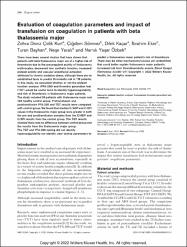Evaluation of coagulation parameters and impact of transfusion on coagulation in patients with beta thalassemia major

Göster/
Erişim
info:eu-repo/semantics/embargoedAccessTarih
05.07.2022Yazar
Çelik Kurt, Zehra DenizSönmez, Çiğdem
Kaçar, Dilek
Eker, İbrahim
Bayhan, Turan
Yaralı, Neşe
Özbek, Namık Yaşar
Üst veri
Tüm öğe kaydını gösterKünye
Kurt, Z. D. Ç., Sönmez, Ç., Kaçar, D., Eker, İ., Bayhan, T., Yarali, N., & Özbek, N. Y. (2022). Evaluation of coagulation parameters and impact of transfusion on coagulation in patients with beta thalassemia major. Blood Coagulation & Fibrinolysis, 33(5), 266-271.Özet
There have been several studies that have shown that
patients with beta thalassemia major are at a higher risk of
thrombosis due to the procoagulant activity of thalassemic
erythrocytes, decreased liver synthetic function, increased
platelet activity and vascular endothelial activation
attributed to chronic oxidative stress, although there are no
established tests to predict thrombotic risk in TM patients.
In this study, we evaluated whether or not the platelet
function analyser (PFA-200) and thrombin generation test
(TGT) would be useful tools to identify hypercoagulability
and risk of thrombosis in thalassemia major patients.
The study included 50 patients with thalassemia major and
104 healthy control group. Pretransfusion and
posttransfusion PFA-200 and TGT results were compared
with control group. We found that median C/ADP and C/EPI
values in the thalassemia major group were greater in both
the pre and posttransfusion samples than the C/ADP and
C/EPI results from the control group. The TGT results
showed there was no difference between control group and
the results from the thalassemia major group.
The TGT and PFA-200 testing did not identify
hypercoagulability nor identify clear testing parameters to
predict a thalassemia major patient’s risk of thrombosis.
There may be other mechanisms/causes yet unidentified
that could better explain thalassemia major patient’s
increased risk from thromboembolic events.















